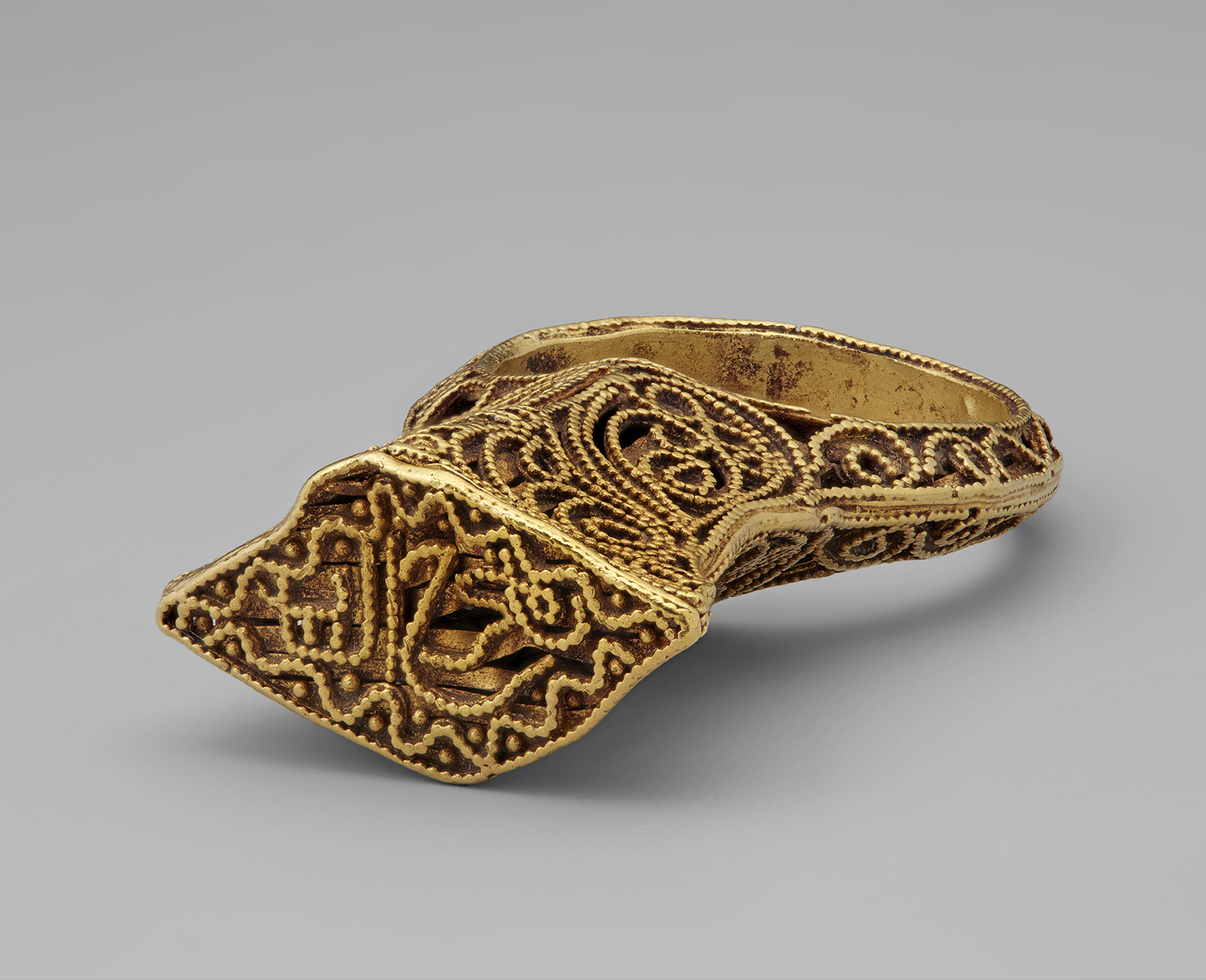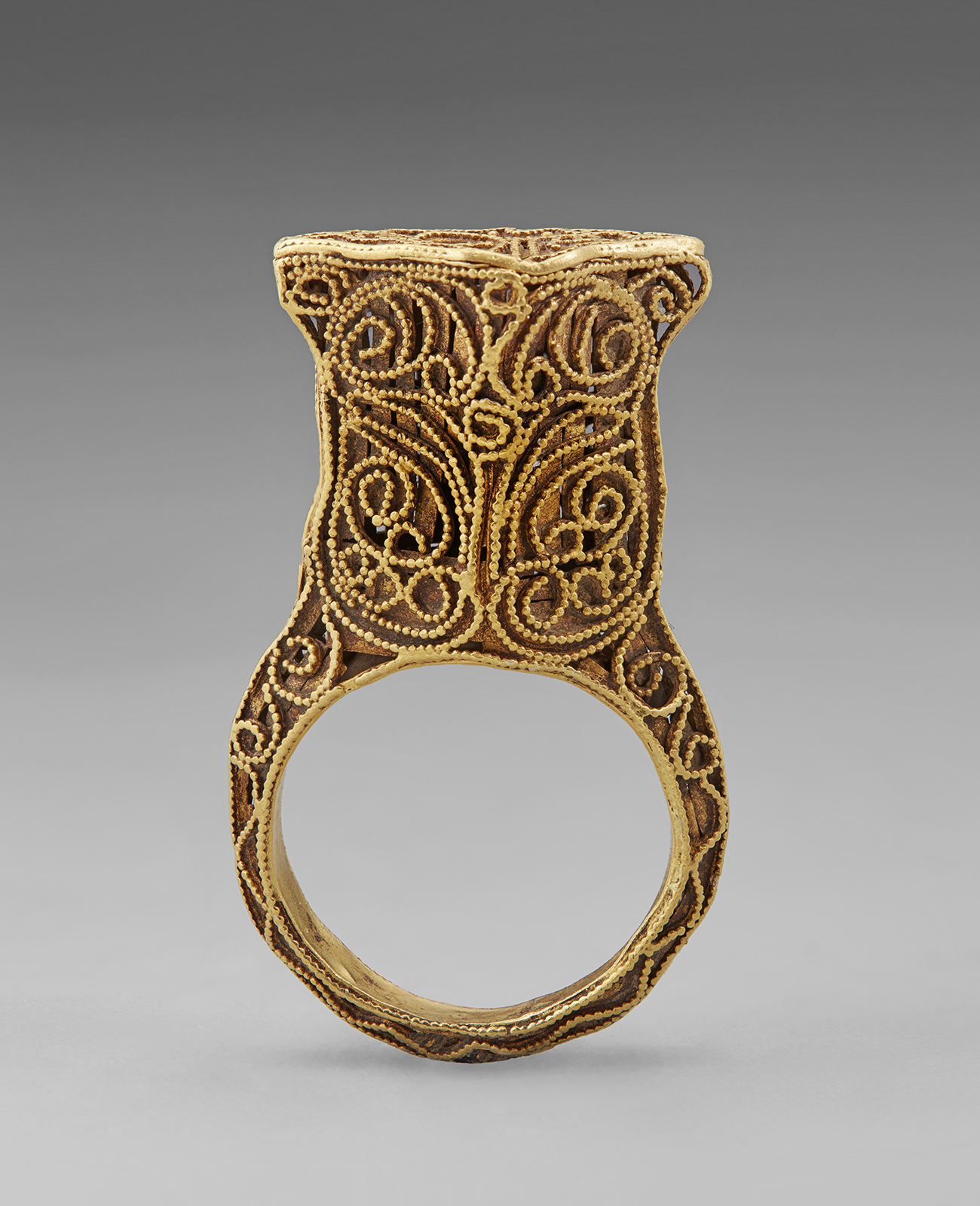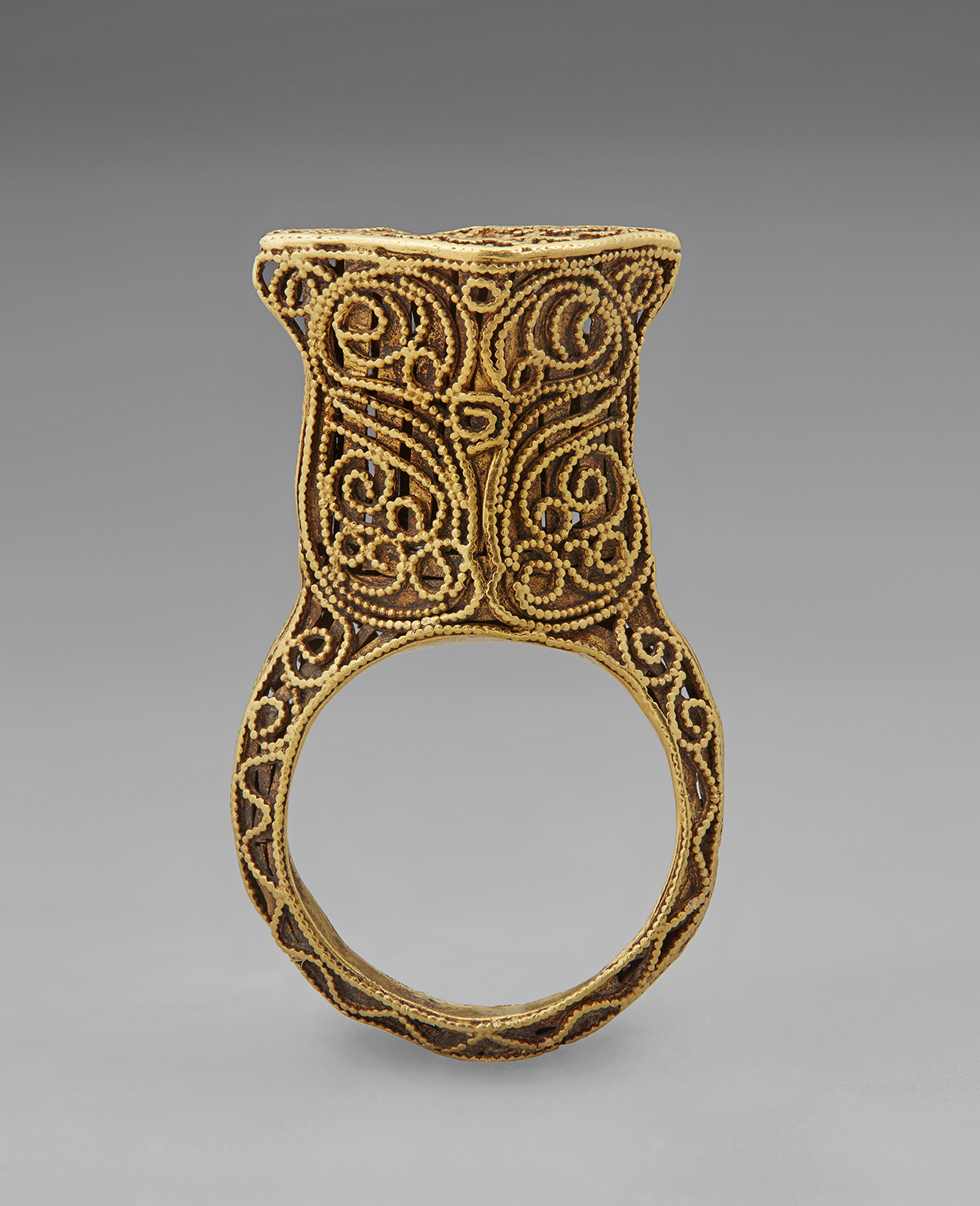Click on the image to zoom
Ring
- Accession Number:AKM948.1
- Place:Egypt
- Dimensions:height 4.0 cm
- Date:11th century
- Materials and Technique:gold; filigree
Gold jewellery produced during the Fatimid Dynasty (909–1171) is among the most opulent of the medieval world. This ring is no exception. Intricately decorated with patterns of gold wire whose voids are filled with fine gold particles, it shows a mastery of two techniques commonly used in Fatimid jewellery: filigree and granulation. Its reliance upon these ornamental techniques rather than upon gem settings is also typical of Fatimid rings. However, its high raised bezel form is better known in rings from the Seljuq period (ca. 1040–1307).
Further Reading
The Fatimids, who derived their name from Fatima, daughter of the Prophet Muhammad, centralized their power in the capital city of Cairo. Their territory stretched across North Africa, and at its maximum extent included areas as far east as the Levant and Hijaz. The Fatimids maintained important trade relations within Africa as well as with empires around the Indian Ocean and Mediterranean Sea. An especially important relationship was formed with the nearby Byzantine Empire (ca. 330–1453), and some Fatimid jewellery has very distinct links to Byzantine objects (see AKM594).
The trove of medieval documents known as the Cairo Geniza provides a great deal of important information about jewellery production during the Fatimid period. These manuscript fragments found in the Ben Ezra Synagogue in Fustat or Old Cairo, Egypt, indicate prices, terminology, and production details about the goldsmithing and jewellery industry, much of which was staffed by Jewish craftsmen. Filigree, for example, is referred to as mushhabbak (latticework) in 12th-century trousseau lists from the Cairo Geniza documents.[1] While filigree remained an important element of Fatimid jewellery, the use of granulation eventually fell to the wayside, something that scholar Marc Rosenberg referred to as “the battle of granulation and filigree” in which the latter eventually prevailed.[2] This analysis suggests that this ring is among the earliest of Fatimid jewel types.
The Fatimids obtained gold from a number of sources, including nearby mines in Nubia (modern-day Sudan) as well as the Kingdom of Ghana. Fatimid artisans also melted down and repurposed metal from older jewellery, a probable fate for many Fatimid pieces which no longer exist today. The infamous looting of the treasury of Fatimid caliph al-Mustansir (1036–94) around 1070 resulted in an irreplaceable loss of many riches from this period.
— Courtney Stewart
Notes
[1] Marilyn Jenkins-Madina in The Glory of Byzantium (New York: The Metropolitan Museum of Art, 1997), 419–20, quoting Goitein, A Mediterranean Society: The Jewish Communities of the Arab World As Portrayed in the Documents of the Cairo Geniza, vol. 4, 211 –12.
[2] Marilyn Jenkins, “Fatimid Jewelry, Its Subtypes and Influences,” Ars Orientalis, vol. 18 (1988), 40, quoting Marc Rosenberg, “Abteilung: Granulation,” Geschichte der Goldschmiedekunst auf Technischer Grundlage, vol. 3. (Frankfurt, 1918), 96–103.
References
Barrucand, Marianne. L'egypte Fatimide: Son Art Et Son Histoire : Actes Du Colloque Organisé À Paris Les 28, 29 Et 30 Mai 1998. Paris: Presses de l'université de Paris-Sorbonne, 1998, 197–217. ISBN: 9782840501626
Bloom, Jonathan M. Arts of the City Victorious. New Haven and London: Yale University Press, 2007. ISBN: 9780300135428
Content, Derek J. Islamic Rings and Gems: The Benjamin Zucker Collection. London: Philip Wilson Publishers, 1987. ISBN: 9780856673337
Ekhtiar, Maryam, Sheila R. Canby, Navina Haidar, and Priscilla P. Soucek, eds. Masterpieces from the Department of Islamic Art in The Metropolitan Museum of Art, 1st ed. New York: The Metropolitan Museum of Art, 2011. ISBN 9781588394347
Goitein, Shelomoh D. A Mediterranean Society: The Jewish Communities of the Arab World As Portrayed in the Documents of the Cairo Geniza. Berkeley: University of California Press, 1999. ISBN: 9780520221581
Jenkins-Madina, Marilyn, and Manuel Keene. Islamic Jewelry in the Metropolitan Museum of Art. New York: Metropolitan Museum of Art, 1983. ISBN: 9780870993268
Jenkins-Madina, Marilyn. "Fatimid Jewelry, Its Subtypes and Influences." Ars Orientalis, vol. 18 (1988), 40, 45, ill. figs. 51, 5b.
O'Kane, Bernard. The Treasures of Islamic Art in the Museums of Cairo. Cairo: American University in Cairo Press, 2006. ISBN: 9789774248603
Rosenberg, Marc. “Abteilung: Granulation.” Geschichte der Goldschmiedekunst auf Technischer Grundlage, vol. 3. Frankfurt: 1918, 96–103.
Spink, Michael and Jack Ogden. The Art of Adornment; Jewellery of the Islamic Lands. Part I and Part II. London: Nour Foundation, 2013. ISBN: 9781874780861
Trésors Fatimides du Caire Exposition Présentée à l'Institut du Monde Arabe du 28 Avril au 30 Aout 1998. Paris: Institut du Monde Arabe, 1998. ISBN: 9782843060113
Wenzel, Marian. Ornament and Amulet: Rings of the Islamic Lands. New York: Nour Foundation in association with Azimuth Editions and Oxford University Press, 1993. ISBN: 9780197276143
Note: This online resource is reviewed and updated on an ongoing basis. We are committed to improving this information and will revise and update knowledge about this object as it becomes available.








